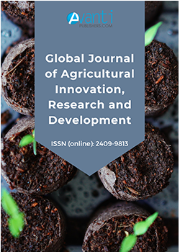Ver ítem
- xmlui.general.dspace_homeCentros Regionales y EEAsCentro Regional Buenos Aires NorteEEA San PedroArtículos científicosxmlui.ArtifactBrowser.ItemViewer.trail
- Inicio
- Centros Regionales y EEAs
- Centro Regional Buenos Aires Norte
- EEA San Pedro
- Artículos científicos
- Ver ítem
Tomato crop health, yield, and greenhouse soil conditions after 17 years of repeated treatments of biofumigation and solarization
Resumen
The combination of biofumigation and solarization is known as bio-solarization. An experiment was performed from 2003 to 2019 in a greenhouse at INTA San Pedro, Buenos Aires province, Argentina (33°44'12.7"S 59°47'58.2"W). Treatments (TRAT) were applied every two years. TRAT evaluated were: 1=Control; 2= Solarization, 3= Biorot, a succession of organic amendments (chicken manure, broccoli, chicken manure, broccoli, tomato, and pepper crop debris, mustard,
[ver mas...]
The combination of biofumigation and solarization is known as bio-solarization. An experiment was performed from 2003 to 2019 in a greenhouse at INTA San Pedro, Buenos Aires province, Argentina (33°44'12.7"S 59°47'58.2"W). Treatments (TRAT) were applied every two years. TRAT evaluated were: 1=Control; 2= Solarization, 3= Biorot, a succession of organic amendments (chicken manure, broccoli, chicken manure, broccoli, tomato, and pepper crop debris, mustard, tomato crop debris, broccoli, tomato crop debris), 4=Biobras based only on the use of brassicas (rapeseed, broccoli, mustard, and Brassica campestris). Treatments were carried out in spring or summer so that a late-season tomato crop could be grown after them. The tomato hybrid planted was Superman (Petoseed), except for the last season where the hybrid used was Rodeo (BHN). Fungal pathogens controlled were Pyrenochaeta lycopersici, Fusarium solani, Sclerotium rolfsii, and Sclerotinia sclerotiorum, and nematodes like Nacobbus aberrans, Helicotylenchus and Criconemella. Fungi of Aspergillus genera were observed growing on death sclerotia of Sclerotinia sclerotiorum and Sclerotium rolfsii in Biobras and Biorot. Tomato plants in control showed a higher percentage of dead plants, root rots, and lower root dry matter at the end of each crop. Solarization alone without adding organic matter reduced this parameter in the soil and showed more death plants and less yield than Biobras and Biorot. Tomato and pepper crop debris used as biofumigants produced high yield values and adequate pathogen control. Biofumigation in combination with solarization is an effective technique for managing soil-borne pathogens in greenhouses and is being adopted by horticultural growers in Argentina.
[Cerrar]

Fuente
Global Journal of Agricultural Innovation, Research & Development 8 : 123-139 (2021).
Fecha
2021
Editorial
Avanti
ISSN
2409-9813
Documentos Relacionados
Formato
pdf
Tipo de documento
artículo
Proyectos
(ver más)
INTA/2019-PE-E1-I009-001/2019-PE-E1-I009-001/AR./Intensificación sostenible de los sistemas de producción bajo cubierta (hortalizas, flores y ornamentales)
Palabras Claves
Derechos de acceso
Abierto
 Excepto donde se diga explicitamente, este item se publica bajo la siguiente descripción: Creative Commons Attribution-NonCommercial-ShareAlike 2.5 Unported (CC BY-NC-SA 2.5)
Excepto donde se diga explicitamente, este item se publica bajo la siguiente descripción: Creative Commons Attribution-NonCommercial-ShareAlike 2.5 Unported (CC BY-NC-SA 2.5)


